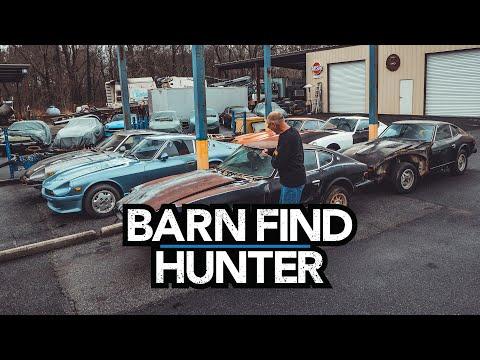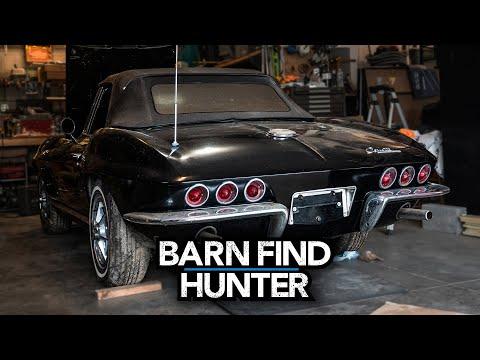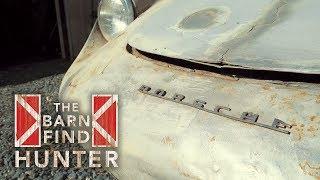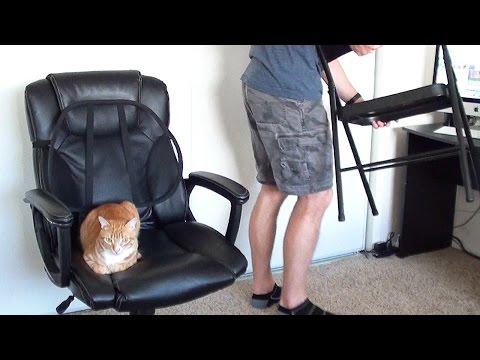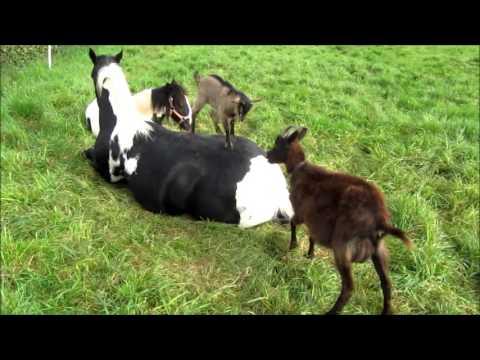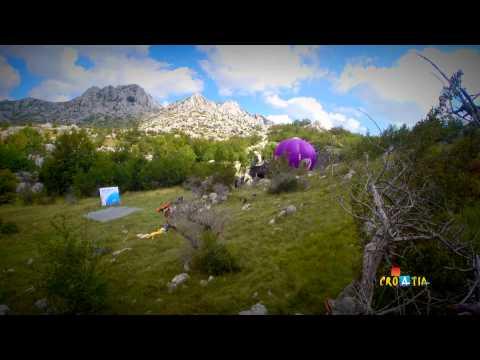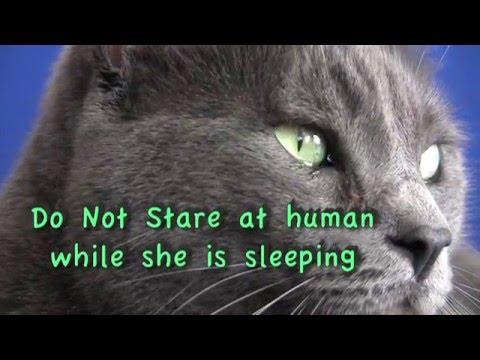Alfa Romeo paradise with a splash of Mazda RX-7 and Porsche 911 | Barn Find Hunter - Ep. 77
Description
Within the SCCA racing scene, Tom has always heard about an Atlanta local legend, Paul Spruell. Paul is a national champion of SCCA G-production and 3x national champ in E-production. Ride along as Tom stops by to see his race shop and hear his stories of barn find cars that he's collected over the years. The fun doesn't stop there! You are in for a real treat as Tom stops by his son Brian's house and reminisce over his barn find's that he has collected over the years. Hagerty is your definitive source for all things classic: compelling stories about cool cars and the people who love them; the latest on collector car values and market trends; and all the eye candy, roaring engines and nostalgia you can handle. So strap down, settle in and cruise with us a while. We’re glad you’re here.
Video Script::
(upbeat music) - Right now we're heading to the race shop of a guy named Paul Spruell, who is an Alfa Romeo expert. I believe his family owned
an Alfa Romeo dealership here when the franchise went away. You know, when Alfa
Romeo left the US market. They remained an Alfa Romeo repair shop, race shop, and built racing engines. And I believe he's got some relics from the past lying around. And so in an effort to bring youthful, more youthful cars to this episode. You know, he's Alfa Romeo, you know, so we're not look
at cars in the 30's and 40's, we're talking about cars
in the 60's and 70's. Well that's our next find, ha! Holy mackerel, look at that lowered van. When we decided to come
to the Atlanta area and look for cars that
were newer than the cars that we find very often
from the 40's and 50's, one of the people I
called was Paul Spruell. Paul is an Alfa Romeo
expert, racer, parts seller, and didn't your family own
the Alfa Romeo dealership in this city? - Yeah. - Well, tell us about that. What years did you own that dealership? - 1980 through '93 when they pulled out. They pulled out in '94. - They pulled out in '94, okay. - We started in 1980 and in 1982 we were, the next
year we were tenth in sales. - In the country? - Yeah. And the next year we were fifth, and the next year we were first. And we were the largest selling
dealer five different years. Always in the top 10. - Man. - And we sold more Afla's than anybody in the history of Alfa in the USA. Until now of course, I'm sure they've sold a lot more cars. - And so they didn't
pull out of the US market because of you, you probably did your fair
share in keeping them here. - We were doing great. We begged them to stay, and they said they would
be back in five years. No, if you leave you will never be back. - Wow. So in addition to selling new Alfa's, I guess you sold used
ones, repairs, parts, and the race team. Now you're an SCCA National
Champion in E production? - Yeah. - What year? - Well G production in '69, E production in '85, '86 and '88. - So four time national champ, I've never met a four time champ. Geez, that's pretty cool. And so you told me you have some old cars sitting around in the
back of the building. I'd love to see those.
- Yes. All right, come on. (soft country music) - So this was your race car
you won three championships in? - Right. - [Tom] And it's been crashed since when? - [Paul] '93. - [Tom] '93. - [Paul] Yeah. - [Tom] And now you're just
getting around to fixing it? - [Paul] Yeah. - [Tom] Did this start off as a new car, or was it a used car? You made a race car out of it. - It was a Duetto. I ran it at Sebring in 1970. - So you've had this a few years? - Yeah, this corner was taken off, suspension and everything. - At Road Atlanta? - Yeah, I was 10 feet
up in the air backwards and going upside down. It landed on four wheels. (laughs) (upbeat music) That's an old '66 Spider Veloce. Now it was a real barn find. I had a towing service
for the Alfa dealership. And one day this driver I didn't even know calls me up and says,
"I've got an old Alfer--" - Alfer? (laughs) - "And I'm fixing to take it
to the, you know, crasher, "and wondered if you'd want it?" I said, "Well drive by,
and I'll let you know." And there was this bare chassis. I said, "What do you want?" He says a hundred bucks. - Now explain to me the Alfers, you know I get so mixed
up with Giulietta's and what's the theory? Like sedans and roadsters, women's names, tell me how does that work out? - Giulietta is little Giuel and that was the 1300's back in the 50's up through '62 was the Giulietta, Spiders, and Sprints and Berlinas, Zagatos and Sprint Speciales. Then they went to Giulia, which is just a regular Giul I guess, and that was the 1600's. That catches you up to now. And now they're starting to
use some of the old names. - Right, okay. Well that explains it. This is a great sedan. So this is a Giulia, which means that it's a 1600. - Yes, there's a TI,
Giulia Super, and TI Super. This is the little one. It's got the webers and the-- - [Tom] Oh man. - It needs an engine. And just the word out. - This is the daily driver kind of car? - [Paul] Yes. - What a great car. - This one is the color
of the police cars. Remember the original Italian job? - Yep, oh yeah. (laughs) Tell us the story of Froggy. - Froggy, this was the Alfa
Factory rep for the Southeast, this was his demonstrator. He sold it to Baker Motor Company, which was a local dealer. And they sold it to a friend of mine and I started working on it. Instead of trading it in, I bought it from him and drove
it for three or four years. I sold it and the guy
turned it into a race car and raced it. I've got a picture of it
running at Road Atlanta, and raced it for a couple of years and sold it to somebody for the street. It was this color when it was raced. That was the original
color, the baby blue. They made a zillion of them. And he painted it bright green. And when they brought
it to us to service it, I was just amazed. - [Tom] What are you asking for this car? - [Paul] I think I've got $7200 on it. - [Tom] With an engine? - [Paul] With the engine. - [Tom] And the gearbox? - Oh yeah, I'll stick
everything back in it. - Is the floor sound in it? I see the body has got some issues. - Go ahead and open the door. The floors are solid. I mean, they've got some rust
on them but they're, you know, they're not perforated or anything. - Is that an SCCA legal roll
cage today, do you think? - Today it still is. It needs some bars to go
into the front suspension. That keeps the engine and suspension from getting in your lap, like the yellow car protected me. - So this would be a good starting point for a vintage race car for sure. So this Spider here,
what about this one here? That's what they call the Boat Tail? - Yeah, yeah. This is a Duetto. - Which means what? - Two of everything. Two webers, two seats, you know, two wiper blades, two headlights. - Two cam shafts, two seater. - They had a contest in
Italy to name this car. And Duetto won. - So what year is this? - This is '68. '67 or '68. And I bought it for of all things, for the deck lid. - Which is now gone. - Yeah. When I wrecked the Duetto out there, the deck lid flew off. I had to go pick up pieces and the guy that made it, it's fiberglass. The guy that made it was no longer around. - And this is a for sale car? - Oh I'd be happy to sell it. Now that I've got a deck lid. - The last on the road
was '87 it looks like. - 1987, it came from
Jacksonville, Florida. - So it's got a little bit of cancer popping around here and there. - It's restorable if
somebody wants to do it, and they're well worth doing. When you can, you know, judge a car, is the floorboards and the wheel well. And you see, they're sound. So if you've got good
floorboards and wheel wells, the rest of it is superfluous. Actually, Alfa Penefrana would very often forget to pain or prime the back side. And in any conditions they're gonna rust. So you know that was the problem. - That's a big trunk. For a little sports car,
this had a long deck on it. - Oh, it's wonderful. - [Tom] And so how much is that car? - A couple of thousand, with the deck lid back on it. - You know, so for 12 grand
you can have all three. And we can take a problem off your hands and give them to somebody else. (upbeat music) So this is a parts car? - This is a sad car. (laughs) - Okay. Oh. - It is so straight-- - Really? - That the rockers and
stuff in the floors. The reason the doors are nice is the fact that he took the doors and the hood and the deck lid off, and put the car outside. - [Tom] This is a GTV? - [Paul] Yes, '66 Giulia. - So the GTV was a two door sport coupe. We saw inside the sports
cars, two seated roadsters, the four door sedans. This was the sports coupe. This is what ran in the
2.5L Trans-Am series against 510's and BMWs. So, the doors were, and the hood and the
trunk were left inside, and this was outside. - Yeah. It's got new wheels on it. It was mired down into sand and I bought the Duetto and
I couldn't walk away from it. - So is that restorable? - Yeah. - I mean there's lots
of little stuff going on here and there. - Lots of detail has to be done. But all the panels are available. You can get the, I think 2,000 will buy ever
panel on here that it needs. - Wow, and what are you asking for this? - I've got 4,200 on it, but I'm flexible. - [Tom] As a complete car? - Well just like it is. The shell.
- [Tom] Just like it is, okay. - What you'd need to have
to do is get a donor car and you've got all the pieces. - Yeah, what's the value of this car? 40,000 maybe when it's done? And you can either have lots more than that into it I'm sure. - This is called the step-nose. And this is the most valuable
of the cars, you see. - Explain why this is called a step-nose and why they did that. - I don't know why they did that. - Cooling, do you think? - I think just styling. I think it's just a design feature. - If you look at this, there's a step here between the
hood and this brown cowling. You would imagine it to be flush, but for some reason Alfa
decided to have it like this, matching this character line there. - Subsequent models they smoothed it in. - Yeah, yeah. I've invited you to my car party for like 20 years now. - Yes. - And I think Dan McCreary, a mutual friend has also invited you, so I'll give you a rain
check for this October. - I'll be there. - All right, cool. - Thank you Tom! - Thank you so much. - It's been a pleasure. (upbeat music) - Paul Spruell, what a neat guy. You know, self taught successful, national championship racer, machinist, engine builder. So now we're going to go see somebody, another young man who's
into imported cars. Cars that are, you know,
30 years old, 40 years old. I think you'll enjoy meeting him. So our idea to come to Atlanta was to find youthful car collectors. People that collected
either cars that were newer than what I would think to be an old car, or people that were young
and into collecting cars. So you've got to understand, when I walk into a garage
and I see a 30's car, or a 40's car, a 50's car, a 60's car, I can relate to it because I was either
born during those times or I read about them, so old hot rods from the
30's mean a lot to me. But people who were born, you know, in the 90's, what cars do they relate to? We're gonna meet a guy
now that collects cars. A younger guy who
actually means a lot to me because he's my son. I want to introduce you to Brian Cotter. - Hello. - And Brian lives and works in Atlanta and has his own little
collection of barn find cars. Both here, and there's
a couple more at home. You've got to get those out
of the garage by the way, because it's getting to be a drag. So rather than me, you
know, talk about these cars, I'll let Brian say, I think the more interesting
one is this one right here, a Mazda RX7, so why don't you go ahead
and tell us about this. - Yeah sure. So this is a 1993 RX7. This was purchased originally
in North Carolina by a farmer, a pretty cool farmer I guess. So I guess he saw this car
advertised in some pamphlet. Went to a local Mazda dealership, Mazda of Concord, North
Carolina I believe. Wanted to go in and buy it but wanted to make sure he liked the car before he took it for a drive. Put down the deposit for the car, took it for a 2,000 mile test
drive to Florida and back. Arrived back in Concord, paid the remainder of the amount
of money he owed on the car and took it home. And he owned it until I purchased it, maybe five or six years ago. So it's a 1993. He drove it regularly throughout the 90's. In the late 90's he started parking it for longer and longer periods of time. You can see on the windshield it was last registered in 2009. I think that's fairly generous because the condition that
it was in when we found it inside the basement of his
farmhouse was pretty rough. - How many miles are on it? - That is a good question. These cars have notoriously
picky electronic systems, which is kind of funny for a Japanese car. The gauge cluster is digital, or the odometer is digital and
those LEDs have burned out. So the last service on the car I believe is the sticker in the windshield. Something like 44,000 miles, but that's one of the
things I haven't been able to get working yet. - Do you think it's more than 50,000? - I think so. - For people watching this who don't know how special this car is. Maybe you want to pop the hood
and talk about mechanically what makes this car pretty special. By the way, when I go to the big junkyard this guy, this is probably gonna be
the hose of Barn Find Hunter. - So nothing too crazy. This is actually a completely stock. RX7 engine, which is fairly unusual for a third generation RX7. A lot of people saw Fast and the furious or one of those movies and
put giant turbos on these, but this is what it should look like if the car is completely stock. This has what's called
a 13V rotary engine, so it's roughly 1,300 CC's,
twin rotor, twin turbo, and what's kind of cool about this engine is it's a sequential turbo charger system, so there's a turbo that spools
pretty quickly at low RPMs, and then there's a larger turbo that spools at higher RPM's, so it's kind of an interesting
experience driving this car. There's a surge of power, there's a long delay, and then another surge of power as the second turbo kicks on. - Would you put some
competition history on this? - Yes, in 2015 I guess it was I entered this in just
about every autocross event I could find in the Atlanta area. It's in a very competitive class, it's an A street which
goes against Z06 Corvettes and M4 BMW's, it's completely out classed, but I ended up winning
the championship that year which is kind of cool and I made it through the entire
season without blowing up, which is pretty rare
I guess for these cars when they're this old and it's really taken no
extra maintenance whatsoever which is kind of nice. For auto crossing, the only
things that I did to it that are not factory, I put a different set of shocks in, which are coney adjustable sport shocks. They are basically a factory equivalent, but you can adjust the
stiffness ever so slightly and I put in a cane in
filtering but other than that it's complete. - And so you wound up in the championship against new or newer Corvettes with a car that has anti plates on it. If you think about a rotary engine, it's the simplest design. There's no vowels, there's no pistons, there's no connecting rods,
there's no crank shift, no cam shift. There are basically two
rotors in this engine, and they spin around and they, it's kind of a triangular looking piece in a circular piece. So fuel and air come
in, they produce power, they're exhausted. And then that's all it is. There's only really was it, is there two moving pieces? - I think three moving parts. - Tree moving pieces in this motor. It's just an amazing design and if you remember
the Jim Downing episode when we went to a shop, his whole career is based on race cars that have a variation of this motor in it. (car engine roaring) So you know, there's no
rods, there's no valves. It's just a quiet engine
that goes literally, if you think about the
old Mazda commercial, a Mazda goes dooo and what it does. There's nothing to make noise. So this design is almost, it's almost like a skin
stretched over a bare chassis. There's only enough room for
the engine and two occupants, not much more than that. There's not wasted space. The car was designed for
and follows function, and if the function was
to be a lightweight, maneuverable, fast and fun sports car, There's no extra gook
hanging off this car. It's an amazing piece of work. Is there a story with this one? I mean I know it, but I
don't want to say everything. - So this is my 911, it's a 1985. This is a gray market import car. I was looking for a
Porsche that I could afford when I was in college, which is fairly difficult
but it was before Porsche's got crazy in price, so what did I want? I wanted a red 930 turbo coupe. Now what could I afford? I could afford a gray market red, I guess minimally original,
somewhat damaged 911 Targa. So that's what I ended up getting. The car needed engine work when I got it. It obviously needs a few things like a Targa top resurfacing. It's not so bad if you take the top off. - So a Targa, I mean
in case you don't know, you take this off and it
becomes a semi convertible. And the back window stays
in place and this Targa bar. So it's kind of half a coupe
and half a convertible. Yeah, it's the advantages of both and the disadvantages of both I've learned over time, but I purchases this
from the widow of a guy who bought this car I
guess in the mid 90's. Huge amounts of receipts
came with the car, but ultimately, he didn't
drive it for, I don't know, close to a decade. It sat in a garage. It seemed like someone at
some point had put diesel gas in the engine, I'm not really sure why that was, so I had to get the gas tank boiled out. Remember that? And then ultimately had
to rebuild the engine because the valve guides and valve seals were so bad in the car. With a little bit of work we were able to bring this
out of a fairly extended rest in someone's garage. - So you have a small two car garage, and you have three cars in it. I think this is an
interesting story as well. - The third car in the two
car garage is a Formula V. Currently it doesn't
have the bodywork on it. The body work I have
stashed in another spot in the basement, but Formula V if you're not familiar is the class of open wheel racing that was popular in the early
to mid to late 60's I guess. And even to this day, but in a little bit of a modified format. But it's a cool class
of open wheel racing. This is a vintage car so
this is a 1967 or 1968. The car was built by a guy
who was just a fan of racing. Lived in North Carolina, he saw someone racing these cars and wanted to build his own. He bought the blueprints
for what was known as a Zinc at that time, and made the
closest thing he could to a Zinc. So the frame of the car looks like a Zinc which is arguably the most
successful Formula V Platform of all time. There's pictures of this car
racing at Daytona in the 60's. This raced I believe in
Nassau, in the Bahamas in a formula V challenge, so it has some pretty cool history. - [Tom] Can you just explain
what the Formula V is? - Yeah, so this is known as a Formula V because it's all Volkswagen
derived components. So in order to keep this
class of racing affordable, the rules are very strict and all of the pieces are based
off of a Volkswagen beetle. So if you look at the front
axle or the front beam, this is a modified front beam
from a Volkswagen Beetle. I believe the thirds portion tube on the top has been removed. If you look at the engine
it's just an air-cooled Volkswagen Beetle engine. It's a very strictly built engine. The rules for building the engines, there's not a lot of leeway so a great performing
Volkswagen Beetle engine in one of these makes
what, 60, 62 horsepower? - And an insanely good
one is 62 horsepower. - Yeah, and the difference in price. - And that's a lot over
a 40 horsepower block, I mean when you bought the Volkswagen new it was 40 horse power, so somehow machinists and
engine builders have managed to squeeze another 20 horsepower out of Volkswagen components. - And in a modern Formula V they don't have to run the fan
(mumbles) on their engines. They can get somewhere in the neighborhood of 70 or 75 horsepower. It also lets you make a more compact body so it's more aerodynamic, but for what this was it
was a pretty cool race car for the 1960's. - You know, you can see
in the Cotter household the apple didn't fall far from the tree. I remember driving around with Brian maybe in our old Porsche
or the MG we have, and he was probably three
and a half or four years old, and we're driving through the country. Just driving, having a nice
time driving through the country and we pull to the gas station to get gas and there was an old, rusty
maybe a '49 Chevy pick up truck. It was just a piece of junk. And I remember I'm filling up gas and Brian said, "Dad, why
don't we buy that old truck "and we can fix it up." I was like wow, this is like natural. I didn't have to teach him
this, it came naturally so anyways, the apple didn't
fall far from the tree. I'm really proud of him. He's making a living in the
automotive business right now, and work for a major German car company. - Skipped home early for this video too, so thanks for getting me out of work. - So you're buying dinner tonight? - Yeah. - Happy hunting. (upbeat music)














